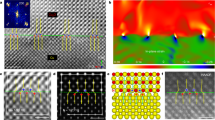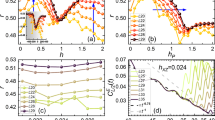Abstract
As rodlike domains pinch off owing to Rayleigh instabilities, a finite-time singularity occurs as the interfacial curvature at the point of pinch-off becomes infinite. The dynamics controlling the interface become independent of initial conditions and, in some cases, the interface attains a universal shape1. Such behaviour occurs in the pinching of liquid jets and bridges2,3,4,5,6,7,8,9 and when pinching occurs by surface diffusion10,11,12. Here we examine an unexplored class of topological singularities where interface motion is controlled by the diffusion of mass through a bulk phase. We show theoretically that the dynamics are determined by a universal solution to the interface shape (which depends only on whether the high-diffusivity phase is the rod or the matrix) and materials parameters. We find good agreement between theory and experimental observations of pinching liquid rods in an Al–Cu alloy. The universal solution applies to any physical system in which interfacial motion is controlled by bulk diffusion, from the break-up of rodlike reinforcing phases in eutectic composites13,14,15,16 to topological singularities that occur during coarsening of interconnected bicontinuous structures17,18,19,20, thus enabling the rate of topological change to be determined in a broad variety of multiphase systems.
This is a preview of subscription content, access via your institution
Access options
Subscribe to this journal
Receive 12 print issues and online access
$259.00 per year
only $21.58 per issue
Buy this article
- Purchase on SpringerLink
- Instant access to full article PDF
Prices may be subject to local taxes which are calculated during checkout




Similar content being viewed by others
References
Eggers, J. Nonlinear dynamics and breakup of free-surface flows. Rev. Mod. Phys. 69, 865–929 (1997).
Keller, J. B. & Miksis, M. J. Surface-tension driven flows. SIAM J. Appl. Math. 43, 268–277 (1983).
Eggers, J. Universal pinching of 3D axisymmetrical free-surface flow. Phys. Rev. Lett. 71, 3458–3460 (1993).
Chen, Y. J. & Steen, P. H. Dynamics of inviscid capillary breakup: Collapse and pinchoff of a film bridge. J. Fluid Mech. 341, 245–267 (1997).
Day, R. F., Hinch, E. J. & Lister, J. R. Self-similar capillary pinchoff of an inviscid fluid. Phys. Rev. Lett. 80, 704–707 (1998).
Zhang, W. W. & Lister, J. R. Similarity solutions for capillary pinch-off in fluids of differing viscosity. Phys. Rev. Lett. 83, 1151–1154 (1999).
Cohen, I., Brenner, M. P., Eggers, J. & Nagel, S. R. Two fluid drop snap-off problem: Experiments and theory. Phys. Rev. Lett. 83, 1147–1150 (1999).
Leppinen, D. & Lister, J. R. Capillary pinch-off in inviscid fluids. Phys. Fluids 15, 568–578 (2003).
Sierou, A. & Lister, J. R. Self-similar recoil of inviscid drops. Phys. Fluids 16, 1379–1394 (2004).
Wong, H., Miksis, M. J., Voorhees, P. W. & Davis, S. H. Capillarity driven motion of solid film wedges. Acta Mater. 45, 2477–2484 (1997).
Wong, H., Miksis, M. J., Voorhees, P. W. & Davis, S. H. Universal pinch off of rods by capillarity-driven surface diffusion. Scr. Mater. 39, 55–60 (1998).
Bernoff, A. J., Bertozzi, A. L. & Witelski, T. P. Axisymmetric surface diffusion: Dynamics and stability of self-similar pinchoff. J. Stat. Phys. 93, 725–776 (1998).
Cline, H. E. Shape instabilities of eutectic composites at elevated temperatures. Acta Metall. 19, 481–490 (1971).
Nakagawa, Y. G. & Weatherly, G. C. Thermal-stability of rod Al3Ni–Al eutectic. Acta Metall. 20, 345–350 (1972).
Majumdar, B. & Chattopadhyay, K. The Rayleigh instability and the origin of rows of droplets in the monotectic microstructure of zinc–bismuth alloys. Metall. Mater. Trans. A 27, 2053–2057 (1996).
Liu, H. Y., Li, Y. & Jones, H. Thermal stability of the α-Zn–Mg2Zn11 and α-Zn–β-Al eutectics obtained by Bridgman growth. J. Mater. Sci. 33, 1159–1164 (1998).
Kwon, Y., Thornton, K. & Voorhees, P. W. Coarsening of bicontinuous structures via nonconserved and conserved dynamics. Phys. Rev. E 75, 021120 (2007).
Kwon, Y., Thornton, K. & Voorhees, P. W. The topology and morphology of bicontinuous interfaces during coarsening. Europhys. Lett. 86, 46005 (2009).
Jain, S. & Bates, F. S. On the origins of morphological complexity in block copolymer surfactants. Science 300, 460–464 (2003).
Davidovitch, B., Ertas, D. & Halsey, T. C. Ripening of porous media. Phys. Rev. E 70, 031609 (2004).
Kurz, W. & Fisher, D. J. Fundamentals of Solidification 3rd edn (Trans Tech Publications, 1992).
Stampanoni, M. et al. Trends in synchrotron-based tomographic imaging: The SLS experience. Dev. X-ray Tomogr. V 6318, U199–U212 (2006).
Fife, J. L. Three-dimensional Characterization and Real-time Interface Dynamics in Aluminum–Copper Dendritic Microstructures. PhD thesis, Northwestern Univ. (2009).
Kammer, D., Mendoza, R. & Voorhees, P. W. Cylindrical domain formation in topologically complex structures. Scr. Mater. 55, 17–22 (2006).
Louzguine-Luzgin, D. V., Louzguina-Luzgina, L. V. & Inoue, A. Deformation behavior of high strength metastable hypereutectic Ti–Fe–Co alloys. Intermetallics 15, 181–186 (2007).
Aagesen, L. K. Phase-Field Simulation of Solidification and Coarsening in Dendritic Microstructures. PhD thesis, Northwestern Univ. (2010).
Gunduz, M. & Hunt, J. D. The measurement of solid–liquid surface energies in the Al–Cu, Al–Si and Pb–Sn systems. Acta Metall. 33, 1651–1672 (1985).
Abramowitz, M. & Stegun, I. A. Handbook of Mathematical Functions with Formulas, Graphs, and Mathematical Tables (National Bureau of Standards Applied Mathematics Series, 55, US Dept. of Commerce : US G.P.O., 1972).
Acknowledgements
This work was partially supported by NSF RTG grant DMS-0636574 (L.K.A.). M.J.M. acknowledges support from US National Science Foundation RTG grant DMS-0636574 and NSF grant DMS-0616468. A.E.J., J.L.F. and P.W.V. acknowledge the US Department of Energy, grant DE-FG02-99ER45782, for financial support. E.M.L. and S.O.P. acknowledge the Danish National Research Foundation for supporting the Center for Fundamental Research: Metal Structures in 4D, within which part of this work was carried out. The authors thank the Paul Scherrer Institut for beam time at the TOMCAT beamlines of the Swiss Light Source. We would also like to thank G. Mikuljan from the TOMCAT team for his support in setting up the experiment at the beamline.
Author information
Authors and Affiliations
Contributions
L.K.A. carried out the theoretical analysis and prepared the manuscript. M.J.M. and P.W.V. were involved with the theoretical calculations. P.W.V. and E.M.L. conceived the experiments. J.L.F., S.O.P. and E.M.L. conducted the experiments. A.E.J. and J.L.F. analysed the experimental data. F.M. and M.S. provided technical guidance for the experiments.
Corresponding author
Ethics declarations
Competing interests
The authors declare no competing financial interests.
Rights and permissions
About this article
Cite this article
Aagesen, L., Johnson, A., Fife, J. et al. Universality and self-similarity in pinch-off of rods by bulk diffusion. Nature Phys 6, 796–800 (2010). https://doi.org/10.1038/nphys1737
Received:
Accepted:
Published:
Issue date:
DOI: https://doi.org/10.1038/nphys1737
This article is cited by
-
Melt Flow-Induced Mechanical Deformation and Fracture Behaviour of Dendrites in Alloy Solidification
Metallurgical and Materials Transactions A (2023)
-
Dissimilar Metal Solution from Solid Alloys as Observed for Steels and Nickel‐Based Alloys in the Presence of Lead‐Based Liquid Alloys or Liquid Tin
JOM (2021)
-
Topology-generating interfacial pattern formation during liquid metal dealloying
Nature Communications (2015)
-
The Morphological Evolution of Low Volume Fraction Tin Dendrites During Coarsening
Metallurgical and Materials Transactions A (2013)



